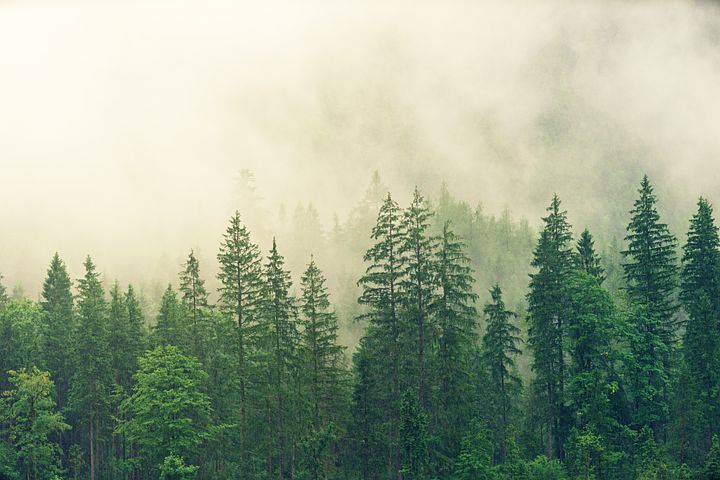Table of Contents
Evergreen Forests: Evergreen forests or rainforests are normally known as blessing of the nature to mankind. Generally, there are around 50+ rainforests globally serving the world with the purity of nature. But, due to drastic changes in the climate, it’s important for us to get aware about evergreen forests of the world and take steps for their conservation.
If you are also here to increase your knowledge about Evergreen Forests, then please read this article fully.
Evergreen Forest
Evergreen forests are forests composed mainly of trees that retain their green foliage throughout the year, as opposed to deciduous forests, where trees shed their leaves annually. These forests are also known as rainforests or tropical forests, and are characterized by their high biodiversity and complex ecosystems.
Evergreen forests are found in various regions around the world, including Central and South America, Central Africa, Southeast Asia, and Australia. Some of the most famous examples of evergreen forests include the Amazon rainforest in South America, the Congo rainforest in Africa, and the tropical rainforests of Southeast Asia.
These forests are home to a wide range of plant and animal species, many of which are unique to these regions and cannot be found anywhere else in the world.
Evergreen Forests in India
There are many important ecological, economic, and cultural benefits associated with evergreen forests. Here are ten examples of their importance:
| Importance | Explanation |
| Biodiversity | Evergreen forests are home to a diverse range of plant and animal species, many of which are endemic to these ecosystems. |
| Climate regulation | The trees in evergreen forests absorb and store large amounts of carbon dioxide from the atmosphere, helping to regulate global climate patterns. |
| Water conservation | Evergreen forests play an important role in regulating the water cycle, helping to maintain soil moisture and prevent erosion. |
| Soil fertility | The fallen leaves and organic matter in evergreen forests help to enrich the soil, promoting the growth of new plants. |
| Medicinal plants | Many medicinal plants and herbs are found in evergreen forests, which have been used for centuries by indigenous communities for traditional healing practices. |
| Timber | Evergreen forests are a valuable source of timber for the construction industry, providing an important source of income for local communities. |
| Ecotourism | Evergreen forests are popular tourist destinations, attracting visitors from around the world who want to experience their natural beauty and wildlife. |
| Carbon sequestration | The trees in evergreen forests store large amounts of carbon, helping to mitigate the effects of climate change. |
| Habitat protection | Evergreen forests provide vital habitat for many endangered and threatened species, helping to protect them from extinction. |
| Cultural significance | Evergreen forests have important cultural and spiritual significance for many indigenous communities, who have lived in harmony with these ecosystems for generations. |
Top 30 Evergreen Forests
We have listed the world’s most popular Top-30 Evergreen Forests below-
| Top 30 Evergreen Forests | Top 30 Evergreen Forests | Top 30 Evergreen Forests |
| 1. Amazon Rainforest, South America
2. Congo Rainforest, Central Africa 3. Southeast Asian Rainforest, Southeast Asia 4. Sundarbans Mangrove Forest, Bangladesh and India 5. Pacific Temperate Rainforest, North America 6. Valdivian Temperate Rainforest, South America 7. Tasmanian Wilderness, Australia 8. Hoh Rainforest, North America 9. Daintree Rainforest, Australia 10. Tongass National Forest, North America |
11. Olympic National Forest, North America
12. Sinharaja Forest Reserve, Sri Lanka 13. Kinabalu National Park, Malaysia 14. Khao Yai National Park, Thailand 15. Mount Gede Pangrango National Park, Indonesia 16. Andes Cloud Forest, South America 17. Santa Elena Cloud Forest Reserve, Costa Rica 18. Monteverde Cloud Forest Reserve, Costa Rica 19. Wstern Ghasts, India 20. Bosawas Biosphere Reserve, Nicaragua
|
21. El Yunque National Forest, Puerto Rico
22. Bwindi Impenetrable Forest, Uganda 23. Borneo Rainforest, Indonesia, Malaysia and Brunei 24. Sundarban, India 25. New Caledonian Rainforest, New Caledonia 26. Guinean Forests of West Africa, West Africa 27. Mata Atlantica Rainforest, Brazil 28. Atsinanana Rainforest, Madagascar 29. Caribbean Pine Forest, Central America and Caribbean 30. Central American Cloud Forest, Central America
|
Evergreen Forests Benefits
We have provided you some of the best economic benefits of Evergreen Forests-
- Evergreen forests are a major source of timber, providing valuable raw material for the wood and paper industries.
- The natural beauty and biodiversity of evergreen forests make them popular tourist destinations, generating income for local communities.
- Evergreen forests play a critical role in regulating the global climate by sequestering carbon dioxide and producing oxygen.
- The roots of evergreen trees help to stabilize soil, reducing erosion and preventing landslides.
- Evergreen forests provide important habitats for a wide range of wildlife, including many endangered species.
- The medicinal properties of many plants found in evergreen forests have led to the development of new drugs and treatments.
- Evergreen forests can serve as important sources of non-timber forest products, such as berries, mushrooms, and wildflowers, which can be harvested sustainably.
- The recreational opportunities provided by evergreen forests, such as hiking, camping, and hunting, can generate significant economic benefits for nearby communities.
- Evergreen forests are a valuable source of renewable energy, as they can be used to produce biofuels and biomass energy.
- The protection of evergreen forests can help to maintain the quality and availability of water resources, which are essential for agriculture and human consumption.
The threats to evergreen forests and their conservation
here are 10 threats to evergreen forests and their conservation, along with a brief explanation for each:
- Deforestation
The conversion of forested land into non-forested land, typically for agriculture, urbanization, or other development purposes, is a major threat to evergreen forests. Deforestation not only reduces the overall area of forested land but also impacts the quality of the remaining forest fragments.
- Illegal logging
The illegal removal of trees and other forest products without proper authorization or permits is a major problem in many areas of the world. Illegal logging can lead to deforestation, habitat destruction, and loss of biodiversity.
- Land-use changes
Conversion of forested land to other uses, such as agriculture, urbanization, or mining activities, can have significant impacts on evergreen forests. Changes in land use can lead to habitat fragmentation, soil erosion, and loss of biodiversity.
- Climate change
Evergreen forests are particularly vulnerable to the impacts of climate change, which can alter precipitation patterns, increase the frequency and intensity of forest fires, and cause changes in the timing of seasonal events for plants and animals.
- Forest fires
Forest fires, whether caused by natural or human factors, can have significant impacts on evergreen forests. Fires can lead to the loss of vegetation, soil degradation, and erosion.
- Mining activities
Mining activities can have significant impacts on evergreen forests, particularly in areas where mining is done on a large scale. Mining can lead to the destruction of habitats, soil erosion, and loss of biodiversity.
- Poaching and hunting
Hunting and poaching of wildlife can have significant impacts on evergreen forests, particularly in areas where hunting is done on a large scale. Overhunting can lead to the loss of biodiversity and disruptions in the ecological balance.
- Invasive species
The introduction of invasive species into evergreen forests can lead to the displacement of native species, leading to a loss of biodiversity and ecological imbalance.
- Air pollution
Air pollution, whether caused by industrial activities or other human factors, can have significant impacts on evergreen forests. Pollution can lead to changes in vegetation, soil degradation, and loss of biodiversity.
- Infrastructure development
Infrastructure development, such as the construction of roads, dams, and other structures, can have significant impacts on evergreen forests. Infrastructure development can lead to habitat fragmentation, soil erosion, and loss of biodiversity.
Evergreen Forest Example
Evergreen forests, also known as rainforests, are characterized by their dense vegetation that remains green and lush throughout the year due to consistent rainfall and warm temperatures. These forests are found in regions with high humidity and ample precipitation. One of the most famous examples of an evergreen forest is the Amazon Rainforest.
Amazon Rainforest: The Amazon Rainforest is the largest tropical rainforest in the world, spanning several countries in South America, including Brazil, Peru, Colombia, and others. It is often referred to as the “Lungs of the Earth” because of its significant role in producing oxygen and absorbing carbon dioxide. The Amazon Rainforest is home to an incredibly diverse range of plant and animal species, many of which are unique to this ecosystem.
The Amazon Rainforest experiences heavy and consistent rainfall throughout the year, supporting the growth of a dense canopy of trees and a rich understory of plants. The forest floor is teeming with life, including insects, amphibians, and various small mammals. Jaguars, anacondas, and diverse bird species are also found in this vibrant ecosystem.
The Amazon Rainforest is not only ecologically important but also culturally significant for indigenous communities that have lived in harmony with the forest for generations. However, the rainforest is under threat due to deforestation, primarily driven by logging, agriculture, and other human activities. Conservation efforts are crucial to preserving the biodiversity and ecological balance of this remarkable evergreen forest.
Other examples of evergreen forests include the Congo Rainforest in Africa, the Southeast Asian Rainforests, and the temperate rainforests of the Pacific Northwest in North America.
Evergreen Forest Matter
Evergreen forests, also known as rainforests or tropical rainforests, are lush and diverse ecosystems characterized by their dense vegetation, high humidity, and consistent rainfall throughout the year. These forests are found in tropical and subtropical regions near the equator, where the climate is warm and wet. Here’s a more detailed look at the key features and components of evergreen forests:
Climate and Precipitation: Evergreen forests receive abundant rainfall, often exceeding 80 inches (200 cm) per year. The consistent rainfall is distributed throughout the year, creating a humid environment. High humidity levels contribute to the growth of diverse plant and animal species.
Canopy and Layers: The forest’s structure is defined by multiple layers, each with distinct plant and animal life. The canopy layer, composed of tall trees with overlapping branches and leaves, forms a dense roof that filters sunlight and supports an intricate ecosystem below.
Understory and Forest Floor: Beneath the canopy lies the understory layer, consisting of smaller trees, shrubs, and young plants. The forest floor is covered with fallen leaves, branches, and decaying organic matter. It is inhabited by various insects, fungi, and decomposers responsible for nutrient recycling.
Biodiversity and Species Richness: Evergreen forests are among the most biodiverse ecosystems on Earth. They support an incredible variety of plant and animal species, many of which are unique and found nowhere else. This biodiversity is crucial for ecological balance and resilience.
Plant Adaptations: The dense vegetation in evergreen forests has led to various plant adaptations. Many trees have tall, straight trunks with smooth bark to prevent the growth of epiphytes (plants that grow on other plants). Others have developed buttress roots for stability in the shallow soil.
Animal Adaptations: Animals in evergreen forests have adapted to the unique environment. Some birds and primates have evolved prehensile tails for gripping branches, while others have vibrant colors for camouflage or communication. Nocturnal species have enhanced senses to navigate the dimly lit forest.
Threats and Conservation: Evergreen forests face threats such as deforestation, habitat loss, and climate change. The clearing of these forests for agriculture, logging, and urbanization poses a significant risk to their biodiversity and ecological functions. Conservation efforts focus on protecting these ecosystems, restoring degraded areas, and promoting sustainable land use practices.
Cultural Importance: Indigenous communities have lived in harmony with evergreen forests for generations, utilizing their resources while maintaining the ecosystem’s integrity. These forests also hold cultural significance for many societies, influencing traditional practices and beliefs.
In conclusion, evergreen forests are remarkable ecosystems that play a vital role in global climate regulation, biodiversity conservation, and cultural heritage. Their unique characteristics and complexity make them a subject of scientific study and a priority for conservation efforts.
Evergreen Forest Trees
Evergreen forests, also known as rainforests or tropical rainforests, are home to a wide variety of tree species that contribute to the lush and diverse ecosystem. These trees have adapted to the constant humidity and consistent rainfall of the tropical climate. Here are some notable tree species commonly found in evergreen forests:
Brazil Nut Tree (Bertholletia excelsa): Native to the Amazon Rainforest, the Brazil nut tree is one of the tallest trees in the rainforest. It produces large fruits containing edible Brazil nuts.
Kapok Tree (Ceiba pentandra): A massive emergent tree found in rainforests across the world, the kapok tree produces fluffy fibers that were traditionally used for filling mattresses and pillows.
Rubber Tree (Hevea brasiliensis): The rubber tree is a key source of natural rubber, obtained from its latex. It’s cultivated in plantations but can also be found in its natural habitat in rainforests.
Mahogany (Swietenia spp.): Mahogany trees are known for their valuable hardwood, often used in furniture and cabinetry. They grow in various tropical rainforests.
Teak (Tectona grandis): Teak trees produce highly durable hardwood used for furniture, boat-building, and construction. They’re found in South and Southeast Asian rainforests.
Cacao Tree (Theobroma cacao): The cacao tree produces cocoa beans, the raw material for chocolate. It thrives in the understory of rainforests.
Rosewood (Dalbergia spp.): Rosewood trees produce prized hardwood used in fine woodworking. However, many species are threatened due to overexploitation.
Strangler Fig (Ficus spp.): Strangler figs are a group of tree species that start as epiphytes (plants growing on other trees) and eventually grow around and “strangle” their host tree. They become self-supporting over time.
Balsa Tree (Ochroma pyramidale): Balsa trees have lightweight wood that is used for various purposes, including making rafts, model airplanes, and crafts.
Dipterocarps (Dipterocarpaceae family): These are a diverse group of large trees commonly found in Southeast Asian rainforests. They are a major component of these forests and contribute to their biodiversity.
Ironwood (Olea spp.): Ironwood trees are known for their dense and hard wood. They are often found in tropical rainforests and are valued for their timber.
Agoho Pine (Casuarina equisetifolia): Found in coastal rainforests and mangrove areas, agoho pines have needle-like leaves and can tolerate saline environments.
These are just a few examples of the many tree species that contribute to the incredible diversity of evergreen forests. Each of these trees plays a unique role in maintaining the balance and ecological functions of these vital ecosystems.


 SOF Olympiad Exam Date 2024-25 Out, Chec...
SOF Olympiad Exam Date 2024-25 Out, Chec...
 NEET Revised Answer Key 2024 Out, Downlo...
NEET Revised Answer Key 2024 Out, Downlo...
 Karnataka PGCET Admit Card 2024 Out, Dow...
Karnataka PGCET Admit Card 2024 Out, Dow...












